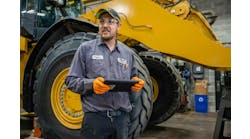Warranty coverage comes auto-matically with every vehicle, piece of equipment and component. A part of every dollar spent goes toward paying for that warranty. It makes good business sense, therefore, to get every possible return on these expenditures. To take full advantage of the warranty coverage available, there needs to be an effective program in place to successfully manage warranty recovery.
New commercial vehicles, due to longer ownership cycles, federally-mandated emission controls and, in some cases, increased utilization, represent an ever-increasing cost of ownership, observes Brian Tabel, retail marketing manager, Isuzu Commercial Truck of America.
“Warranty recovery for even minor repairs can help reduce the running costs,” he says. “Also, it gives the fleets a better understanding of the operating costs and, if properly tracked, can tell them what trucks are performing the best.”
“Warranty recovery is a major element of what fleets need to be considering,” Charles Bergeon, national account executive for Eaton, says. “It is a controllable maintenance expense that could represent anywhere from eight to 20 percent of repair costs. In addition, the process helps the OEM focus on how to reduce warranty claims and, thereby, improve the reliability of the product.”
Warrant recovery helps keep the manufactures in line and forces them to provide quality and durability,” adds Darry W. Stuart, president and CEO, DWS Fleet Management Services, an independent “Limited Time Executive” transportation and fleet management business.
“Warranty is one of the key indicators that all OEMs and component suppliers look at to determine where engineering needs to focus for quality and product improvements,” John Needham, Eaton’s manager of warranty operations, points out.
“It’s the customer’s right, under the terms of the warranty certificate, to not have to pay for a repair caused by a defect in material or workmanship,” notes Mike Kalkoske, quality services manager, Kenworth Truck Company.
“It is paramount that fleets recover any and all warranty costs they are entitled to in order to minimize the total costs associated with the repairs and to maximize their profitability, says D. Mike Pennington, senior director, global communications and industry relations, ArvinMeritor.
“In ‘olden days,’ fleets did not chase $200 to $300 warranty costs,” he says. “Yet today, they will pursue a claim for $50. In fact, the average claim is for $50 to $75.”
Additional, warranty recovery for a fleet is important because lifecycle costs are more accurate, and that allows for better new vehicle spec’ing and tighter cost containment, adds Richard L. Matosky, president, CASCOR, Inc., a company specializing in fleet warranty administration. One of the best ways for a fleet to improve its bottom line and reduce overall fleet lifecycle costs is to capture as much warranty reimbursement as possible or to direct work to vendors who will do the work under warranty at no or reduced cost, he says.
WARRANTY COVERAGE
“In today’s day of complexity in warranty coverages, it is critical that the end-user/buyer know what he is getting,” stresses ArvinMeritor’s Pennington. Reviewing and understanding a manufacturer’s warranty is critical, Eaton’s Bergeon and Needham concur. “Not fully understanding the warranty could adversely impact it if proper warranty practices are not followed.”
More and more, fleets are taking advantages of extensions of warranty offered by component suppliers and OEMS, says Pennington. “Some of these may overlap, causing a fleet to pay for coverages it may already be entitled to.
“In the case of Tier 2 suppliers, often they might provide warranty coverage in the actual part replacement itself, but not the labor costs nor the cumulative-damaged area.”
Many fleets don’t totally understand warranty and think that everything is under it, comments DWS Fleet Management Services’ Stuart. “Normal wear and tear is not covered, nor is ‘driver or operationally failed.’
Sadly, many fleets don’t collect much or any warranty at all, he says, and there are fleets that pay for extended warranties and never collect on these either.
FORMAL PROGRAM
“If you can’t track warranty, you can’t not manage it,” emphasizes Stuart.
Without a systematic process to properly track and manage warranty recovery, a fleet has no way of tracking the overall costs of the vehicles, says Tabel of Isuzu. Many fleets today have several truck brands in their fleets and each truck OEM has its own specific policies for warranty claim processing and payment.
Adds Kenworth’s Kalkoske: “Customers should know where each vehicle is in its warranty period so that they don’t pay for repairs that are actually covered under the vehicle or component warranty.”
Without a formal warranty recovery program, all trucks and components could easily be considered equal, when in fact, that might not be the case,” Eaton’s Needham says. “Additionally, fleets are constantly looking for the highest quality product in order to minimize the amount of time a truck is down for repairs. A formal program provides the data to support that.”
“A warranty tracking program is also a product quality tracking program,” Bergeon of Eaton adds. “That data should be used to engage with the OE to identify potential product improvements and help drive a solution to any issues.
“A warranty tracking program also can be utilized to identify potential areas for training, either because the operator’s practices may be a contributor to claims or because a higher repair frequency will benefit from additional technical expertise.”
PROGRAM ELEMENTS
The essential component to a successful warranty recovery program is information, maintains CASCOR’s Matosky. Fleets must understand the three Cs: complaint, cause and correction.
He advises including OEM parts and labor information, accurate mileage and some level of comments on every repair order opened – no matter whether it is a warranty repair, a PM or an outside repair.
“Complete information is the key to a well run fleet,” he says, “because it helps a fleet fully utilize the investment it makes in the vehicles it purchases, in its costly fleet management systems and in the expensive people hired to repair and manage the fleet. If the right information is input on each and every repair order, a fleet can report against this information and keep a pulse on how it is doing in real time.”
Kalkoske of Kenworth recommends having dedicated people assigned to warranty administration. “Having a person knowledgeable of the various warranties that may apply to a fleet’s vehicles will reduce confusion over what is and isn’t covered and for how long, and will help the fleet customer avoid unnecessary repair costs.”
Isuzu’s Tabel agree. “Because each OEM has its own warranty policies – and they can vary, the more knowledge and experience a warranty administrator has, the more likely the fleet is going to be properly and timely reimbursed.”
Moreover, there needs to be “follow up to insure that claims are paid timely, and that what a fleet submits for reimbursement is in fact what is paid,” continues Tabel.
For claims paid short, he suggests that fleets should demand the OEM explain why the claim is being paid for less then what was applied for.
“In large fleets (400 vehicles or more in operation), it is necessary to have one or more people assigned to the task,” he advises. “This is not a part time job. Warranty repairs can be thousands of dollars and the new vehicle purchase price includes the OEM’s estimated warranty cost per vehicle. A fleet pays for the warranty and they deserve to be fairly reimbursed for their work.”
“Successful warranty administrators should include as much rigor as is reasonable at the repair point and include detailed repair information and coding,” asserts Eaton’s Bergeon. “It should also include a feedback loop to the repair point on all claim denials and the reasons for it.”
There also ought to be a “system that provides the supply base the information they need to quickly and efficiently process their claims,” says Needham of Eaton. “Claim quality is a very important factor in reducing the rework in the claim process flow.”
“The most important advice I can offer is to know the terms and conditions of the vehicle and component warranties,” Kenworth’s Kalkoske says. “A fleet should have a strong relationship with their selling dealer. The dealer can, at times, intercede on the customer’s behalf and ask for policy consideration through the field service organization if there are extenuating circumstances that should be considered.
“If a fleet is capable to do warrantable repair work, it needs to keep their technicians trained and tools in good shape so that warranty claims aren’t rejected due to ‘improper repairs, no defect found.’”
SOFTWARE PROGRAMS
There are a wide variety of commercially available warranty recovery software programs that can make the warranty process more efficient.
“One of the most daunting tasks of warranty administration is identifying potential claims in the mass of paperwork that flows through a maintenance system,” says Dave Walters, technical sales manager, TMW Systems, a developer of enterprise management software for the surface transportation services industry. “Without computerization, this task requires a manual review of each document by a skilled warranty administrator or team of individuals based on the volume of repairs.
“This manual process occurs after-the-fact and eliminates the option of optimizing the warranty solution. Computerized, electronic records lay the foundation for automated warranty identification and warranty alerts in real-time, whereby the fleet can optimize a repair solution.”
“Inputting data into a software program provides an avenue to track all warranty information, adds Andrew Lewellyn, senior sales consultant, Collective Data, an industry-leading fleet management software provider.
“It’s a lot like automatic bill pay,” Lewellyn continues. “Customers can enter in their billing data and not have to worry about it anymore. Warranty recapture in software provides the security of knowing that all warranty information is logged, tracked, recouped and reportable.”
SOFTWARE MODULES
Some warranty software systems can identify warrantable repairs at the creation of the repair order or outside repair. TMW Systems’ Walters says that by building the vehicle warranty schedule into the vehicle master file, the system will monitor each repair order and each individual repair order line for potential warranty.
This early identification allows the fleet to optimize a repair solution, order parts or farm out the work to the warranty provider.
Software programs also have the ability to alert a service writer or technician that a particular job or task may be covered under warranty, says Marc Knight senior consultant, AssetWorks, an industry-leading provider of technology and consulting solutions for asset-and-infrastructure-intensive organizations.
“When work orders are created in real time as the work is done, such alerts can prompt maintenance managers to determine if the job should be sent to the vendor covering the warranty or, if the shop is an authorized to do the warranty, take the steps necessary to capture the information to file a claim with the vendor.
“Systems may also have a warranty claims processing function that takes the labor and part charges from the warranty job and uses that information to file a claim with the vendor. These modules link the repair to the claim, track the status of the claim and then apply any reimbursement back to the work order the claim is linked to.
“This allows a fleet to manage its warranty reimbursements and insure that claims are filed and paid,” Knight goes on. “Additionally, fleets can compare the cost of the work against the reimbursed amount to see the financial impact of warranty activity against its bottom line.”
Some software systems also have modules and tools that provide the ability to see not only vehicle warranty, but also part warranties on the vehicle before the vehicle ever hits the shop, notes Collective Data’s Lewellyn.
As technicians are looking through their work orders, they will actually have a list of all items covered under warranty on that vehicle, as well as the vehicle warranty itself.
Fleets that rely on technicians to get the work done and then just process invoices after-the-fact usually have the lowest rates of warranty recovery, AssetWorks’ Knight says, points out.
“If the work is done, and it is not done by an authorized warranty provider or not documented correctly, even if covered, the fleet may not get the reimbursement it is entitled to.”
TECHNICIAN IMPACT
“The technician is the key gatekeeper of warranty recovery,” says Needham of Eaton. “Along with an electronic system that can identify the repair is within the warranty period, the technician has to help manage the repair in order to obtain recovery. The three Cs – complaint, cause and correction – are critical. Failed part retention is another typical requirement the technician must manage.”
While very capable of repairing vehicles, technicians for the most part are not administrators, Tabel of Isuzu’s adds. “They follow instructions and perform work as directed.
He recommends keeping technicians under or on the vehicles – as that is where they are most productive, and having them follow three Cs. “Require them to provide as much detail as necessary to support the repair. An experienced warranty administrator can fill in the blanks and add information as needed to meet the OEM requirements.
“Do not depend on technicians to determine warranty eligibility for a given repair. That is the service shop management’s responsibility.”
“Most technicians are well trained on the nuances of what is and what is not warranty, remarks Pennington of ArvinMeritor. “Failure analysis is really not usually in their skill set, and they could use rudimentary knowledge, but of primary importance is the ability to make the correct diagnosis and repairs.
“Generally, technicians depend on supervisors and managers to determine warranty and recovery ability. Technicians do know how long a repair job takes, but only a portion of those hours may qualify for warranty recovery.”
“In most cases, repairs can be filtered and identified as a system more accurately when the technician is on the front and back end of the process,” says Eaton’s Bergeon.
“The technician also must be aware of critical claim requirements, like ECM downloads for codes. Equally important is a feedback loop to the technician if this information is lacking or warranty processes were not followed correctly.”




